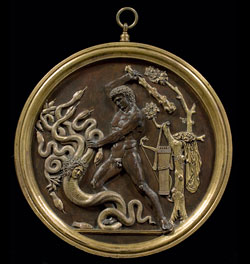First Look at Antico's Rare Renaissance Sculpture on View at The Frick Collection
 Pier Jacopo Alari Bonacolsi, called Antico (c. 1455-1528), Hercules and the Lernaean Hydra, c. 1496. Bronze with gilding, 12 7/8 inches. Museo Nazionale del Bargello, Florence.
Pier Jacopo Alari Bonacolsi, called Antico (c. 1455-1528), Hercules and the Lernaean Hydra, c. 1496. Bronze with gilding, 12 7/8 inches. Museo Nazionale del Bargello, Florence. Photograph courtesy of Domingie & Rabatti Firenze
The works of Pier Jacopo Alari Bonacolsi, known as Antico (c. 1455-1528), a transformative bronze sculptor who brought the classical world to life, are on view for the first time in the United States at The Frick Collection, in New York City.
The acclaimed exhibition is on view through July 29, featuring 46 works of art that comprise almost three-quarters of the master's rare surviving oeuvre. Antico: The Golden Age of Renaissance Bronzes was organized by the National Gallery of Art, Washington, in association with The Frick Collection, New York.
"Following the critical acclaim of the 2008 exhibition Andrea Riccio: Renaissance Master of bronze, we were delighted to join the National Gallery of Art and the Kunsthistorisches Museum in studying another remarkable Northern Italian artist whose oeuvre deserved better recognition in America," comments co-curator Denise Allen. As with Riccio, Antico is represented in the Frick's holdings, and we have come to appreciate our work better by placing it in the context of these loans from major public and private collections worldwide."
Antico was the first Renaissance master to perfect the ancient art of indirect casting, which allows an artist to make many bronze versions of his sculptures using molds taken from a single wax model, Antico's bronzes always seem to have been as rare as exceptional antiquities. Few works that were cast during Antico's lifetime exist in multiple examples. Some, like the Meleager, are unique. The Hercules is known in four versions, the Apollo in only three. Comparison of Antico's two Seated Nymphs reveals some of the small, but significant, differences that can exist between bronzes that derive from the same wax model. The hair of one is pulled into a knot above her brow, and each curl is gracefully articulated. The other wears a plain diadem. She is simpler overall and was probably less highly worked in the wax casting model than her more elaborate counterpart. Such differences may also reflect the fact that Antico often entrusted other masters to cast his bronzes. Although Antico's replicative casting technique might have generated a lucrative income, he apparently did not undertake the serial production of his works.
Resources:
Also in this Issue:
- The Fired Copper Works of Kara Young
- When Innovative Processes Combine, The Result Is Breathtaking
- Weaving His Way Through Copper: David Paul Bacharach
- Renee Lammers: Plein Air Copper Painter
- First Look at Antico's Rare Renaissance Sculpture on View at The Frick Collection
